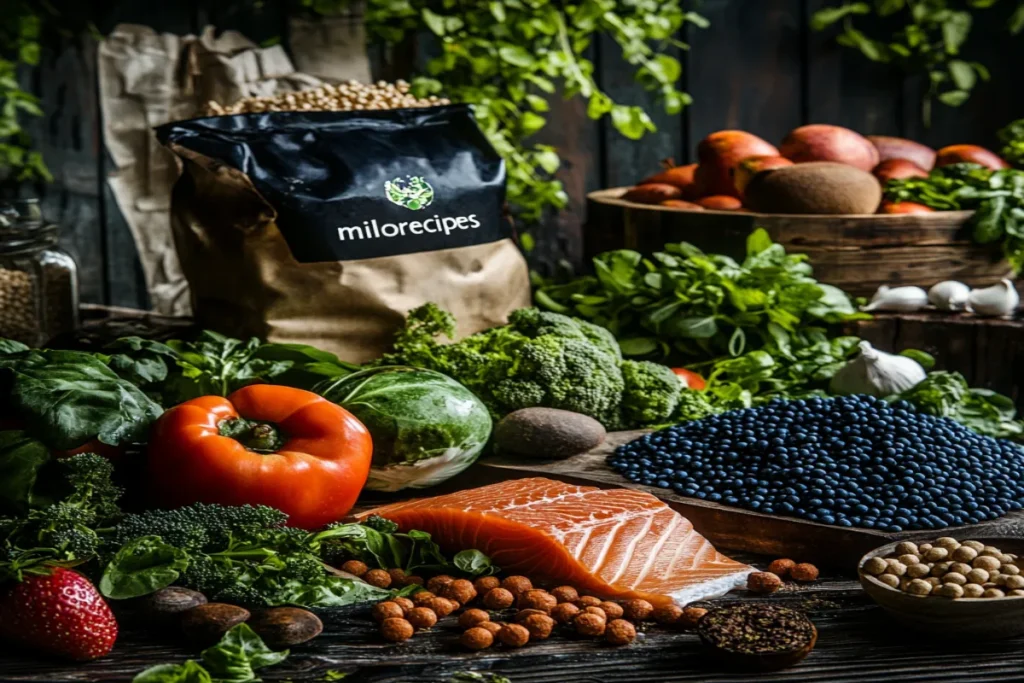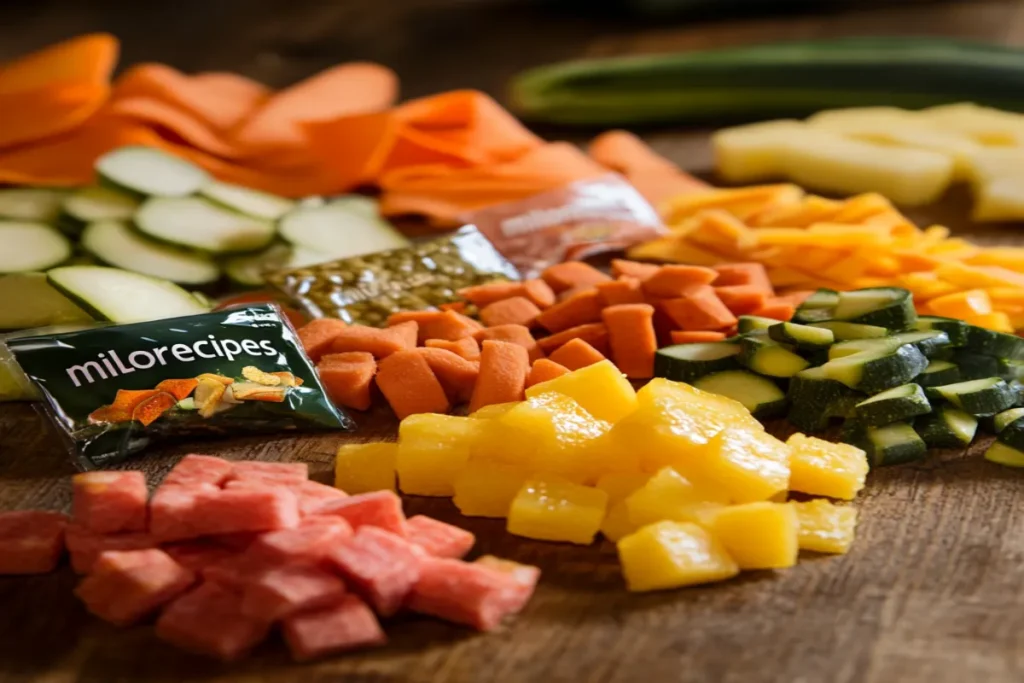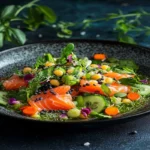Imagine standing by your aquarium, watching your vibrant fish dart around. Their scales shimmer in the light. These aquatic friends depend on you for their health and vitality. What better way to show love than by making a homemade fish food recipe just for them?
Creating nutritious fish food at home is more than saving money. It’s a chance to improve your pets’ well-being. With simple ingredients, you can make a protein-rich, nutrient-packed fish food. This ensures your fish stay healthy and happy.
Store-bought fish food often has hidden preservatives and questionable ingredients. But, with a homemade recipe, you control every ingredient. This article will show you how to make a fish food recipe full of essential nutrients. It keeps your aquatic friends healthy and content. Dive in and discover the joy of nurturing your fish through homemade nutrition!
Table of Contents
Understanding the Importance of Homemade Fish Food
Making homemade fish food lets you tailor your fish’s diet to their needs. It helps avoid fillers and additives found in store-bought food. You can add more protein, vitamins, and minerals for better health and color.
Many fish need different foods. For example, homemade gel food for gel fish can have over 55% protein. This is key for growth, reproduction, and immune health. You can also add lipids from fish oil and vegetable oils for energy and cell structure.
Customizing fish food recipes is very beneficial. You can add carbs from grains for energy and vitamins A, D, E, and B for metabolism. A balanced diet is vital for your fish’s health and long life.
Creating homemade fish food strengthens your bond with your fish. It shows you care about their nutrition and well-being. A varied diet prevents deficiencies and improves color, thanks to carotenoids from different foods. Preparing homemade food can make your fish healthier and happier.
Benefits of Using a Fish Food Recipe

Using a fish food recipe has many benefits for your fish’s health and your experience as an aquarist. One big plus is saving money. Homemade fish food is often cheaper than buying commercial food, yet it gives your fish the best nutrition.
Homemade fish food is packed with nutrients. Studies show that a diet rich in protein helps fish grow and stay healthy. By making your own food, you can avoid additives and fillers found in store-bought options. Fish food recipe benefits also include customizing recipes for different fish species.
When you make fish food at home, you can try out different flavors and textures. This lets you match your fish’s preferences, making them happier and healthier. Plus, making your own food is better for the environment, reducing waste from mass-produced feeds.
In summary, the homemade fish food advantages go beyond just saving time. They include better health, sustainability, and saving money. This makes it a smart choice for fish owners who care deeply about their pets.
Essential Ingredients for Homemade Fish Food

Making your own fish food means picking the right ingredients. Protein sources are key for a healthy diet. Fish meal, shrimp meal, and squid meal give your fish the amino acids they need for muscle growth. These ingredients help your fish grow strong and healthy.
Vegetables are also vital for your fish’s diet. Zucchini, peas, and spinach add important vitamins like Vitamin C. This vitamin boosts your fish’s immune system. Spirulina, a type of algae, adds protein and Vitamin B to their diet.
Fats are important too. Fish oil and flaxseed oil provide fatty acids that keep your fish healthy. Carbohydrates like whole wheat flour and oats give energy and help with digestion.
Using these ingredients lets you tailor your fish food to their needs. It can make your fish grow 20-30% faster than with store-bought food. Choosing the right ingredients and storing them properly keeps your fish’s diet fresh and nutritious.
Step-by-Step Guide to Making Fish Food

Making homemade fish food is easy and fun. Start by getting your ingredients ready. You’ll need high-quality fish flakes, spirulina, and gelatin. First, prepare your ingredients well.
Measure out your ingredients carefully. Mix two parts of dry stuff like fish flakes and spirulina with one part of warm water. Add gelatin slowly to adjust the mix’s thickness. Use more gelatin for sinking food and less for floating food. Stir until everything is mixed well.
Then, heat the mix gently. Keep it on low heat until the gelatin melts fully. This makes the mix smooth and lump-free. When it’s gel-like, put it on a flat surface to cool a bit.
After cooling, cut the gel into small pieces. This makes sure each fish gets the right amount of food. Store these pieces in airtight containers in the fridge or freezer to keep them fresh.
By following these simple steps, you can make healthy fish food at home. Feeding your fish this homemade food keeps them healthy and makes your aquarium better.
Creating a Simple Fish Food Recipe
Making your own fish food can be fun and rewarding. With a few simple ingredients, you can feed your fish well. You’ll need to pick the right parts and have the right tools for an easy recipe.
Ingredients Needed for Your Recipe
- Canned Salmon: A great source of protein.
- Spirulina Algae: Offers essential nutrients.
- Unflavored Gelatin: Acts as a binding agent.
- Ground Fish Meal: Enriches the recipe with additional proteins.
- Vitamin Powder: Enhances the nutritional value, ensuring your fish receive vital supplements.
Equipment and Tools Required
Having the right tools makes cooking fish food easier. You’ll need:
- Blender: To create a smooth mixture.
- Cooking Pot: Useful for boiling the gelatin.
- Molds: For shaping the fish food into manageable pieces.
- Spoon: To help mix and distribute ingredients evenly.
How to Incorporate Nutritional Elements in Your Fish Food
Making nutritious fish food means knowing the key ingredients and their benefits. Adding supplements like fish oil is a good start. It gives fish the omega-3 and omega-6 fatty acids they need for healthy skin and scales. These fats also help with brain development.
Using cod liver oil is also key. It adds vitamins A and D to the food. Tailoring your recipe to fit different fish species is important. Young fish, for example, need more fat to grow well.
Adding fresh veggies and algae is a smart move. They provide vitamins and help with digestion. They also make your fish look more colorful. Lean proteins like fish meal and shrimp are great for building muscle.
By adding these nutrient-rich ingredients, you make your fish food better. It helps them grow strong and stay healthy. Watching how your fish act and feel helps you fine-tune their diet. This way, they can live their best lives in your tank.
Adjusting Your Fish Food Recipe for Different Fish Types
Creating custom fish food recipes helps meet the needs of different fish species. Knowing the differences between tropical and coldwater fish is key. Each type needs specific foods based on their activity and natural home.
Tropical Fish vs. Coldwater Fish
Tropical fish love warmer water and need more protein for their fast metabolism. Angelfish and Betta fish do well on recipes with bloodworms, granules, and flakes. These foods help them grow and stay colorful.
Coldwater fish, like Goldfish and Koi Carp, prefer carbs to keep their energy up in cooler water. They do well on high-quality pellets with veggies and sometimes live food. It’s important to feed them the right amount, based on their size and how they digest food.
| Fish Type | Dietary Preference | Recommended Foods |
|---|---|---|
| Tropical Fish | High in protein | Bloodworms, granules, flakes |
| Coldwater Fish | Higher in carbohydrates | Pellets, vegetables, live foods |
How often you feed fish is also important. Most fish eat twice a day, but young fry might need up to five meals. Watching your fish eat helps make sure they’re doing well and not having diet problems.
Changing your fish food recipes for different species not only meets their needs but also boosts their health and life span. This makes your aquarium a lively and healthy place.
Fish Food Recipe Variations and Customizations
Exploring fish food recipe variations opens a world of creativity. Customizing homemade fish food lets you tailor it to specific fish species. This boosts their nutrition and makes mealtime more exciting. Try swapping proteins like shrimp or mussels, or adding veggies like spinach or zucchini for different tastes and textures.
Adding natural color enhancers like astaxanthin can make your fish look more vibrant. This not only improves their color but also shows you care about their health. By trying new things, you can create recipes that your fish will love.
Sharing your fish food adventures can inspire others. Write about what works and what looks good in your tank. Making homemade fish food is a fun way to enrich your fish’s diet and your own creativity.
| Variation | Main Ingredients | Nutritional Benefits |
|---|---|---|
| Color Boost Blend | Astaxanthin, Sweet Potatoes, Spinach | Enhances colors and vitamins |
| Protein Power Mix | Shrimp, Mussels, Peas | High in protein, supports growth |
| Herb Infusion Recipe | Coriander, Parsley, Carom Seeds | Improves digestion, adds nutrients |
| Simple Veggie Delight | Carrots, Zucchini, Kale | Rich in fiber, encourages healthy digestion |
Storing and Preserving Your Homemade Fish Food
Keeping your homemade fish food fresh and safe is key. Use airtight containers to stop freezer burn and keep moisture out. This is important because fish food is mostly water, about 80%.
Divide your fish food into small containers or bags for easy use. This way, you only take out what you need, keeping the rest fresh. Freeze the food in manageable sizes for easy thawing. Make sure to leave a 1-inch headspace for expansion when freezing.
The shelf life of homemade fish food depends on how you store it. Sealed jars can last months in cool temperatures, 50 to 70 °F. Unsealed jars should be used within a week and can be frozen for up to a year. But, high temperatures over 95 °F can spoil it quickly. Always check jars for ring bands to spot broken seals.
Here are some tips for keeping your homemade fish food fresh:
- Cool jars for 12 to 24 hours before testing seals; a properly sealed lid will produce a ringing sound when tapped.
- Inspect lids; if they are bulging or flat, this may indicate a seal failure.
- Store canned goods in a cool, dark place, free from direct sunlight and heat sources.
Always follow these guidelines to keep your fish healthy. Storing and preserving homemade fish food the right way protects your investment. It also ensures your fish get the highest quality nutrition.
Conclusion
Making your own fish food has many benefits. You can create a recipe that meets your fish’s nutritional needs. This ensures they get all the vitamins and minerals they need to stay healthy.
Homemade fish food reduces the risk of mycotoxins found in store-bought feeds. It also helps you avoid harmful additives often found in commercial fish food.
Preparing homemade fish meals boosts your fish’s health. A customized fish food recipe can greatly benefit their well-being. It supports their growth and helps them fight off diseases.
Using whole fish meal and other diverse ingredients is key. This approach ensures your fish get the nutrients they need.
By making nutritious meals for your fish, you improve their health. This effort strengthens your bond with them. Start using the tips and knowledge you’ve learned to enhance their diet and create a thriving environment.
For more delicious recipes and kitchen inspiration, stick around and explore our other articles.

Homemade Fish Food Recipe – Nutritious & Easy!
- Total Time: 25min
- Yield: Varies based on batch size
Description
This article provides a comprehensive guide to creating homemade fish food, emphasizing its nutritional benefits, cost-effectiveness, and customization potential. It highlights the importance of tailoring meals to meet the specific dietary needs of different fish species, ensuring optimal health and longevity. The article includes detailed recipes, preparation steps, and tips for feeding, as well as advice on monitoring fish health and adjusting diets accordingly. Additionally, it discusses the advantages of using fresh ingredients over commercial options and offers practical storage solutions for homemade fish food
Ingredients
- Animal-Based Proteins:
- Fish fillets (e.g., haddock, salmon)
- Shrimp
- Squid
- Antarctic krill
- Vegetable Additions:
- Peas
- Zucchini
- Algae wafers
- Spinach
- Supplements and Additives:
- Omega-3 fatty acids
- Vitamins
- Gelatin (for binding)
Instructions
- Gathering Ingredients:
- Choose high-quality proteins like fish or shrimp.
- Add vegetables such as spinach or peas.
- Preparation Steps:
- Chop ingredients into small pieces for easier blending.
- Blend proteins, vegetables, and supplements into a smooth paste.
- Add gelatin to help the mixture stick together.
- Molding and Freezing:
- Pour the mixture into molds or containers.
- Chill in the fridge to set.
- Freeze for long-term storage.
Notes
- Tailor the ingredients based on the dietary needs of your fish species (carnivores, herbivores, omnivores).
- Use gelatin to bind the food, making it easy to portion and feed.
- Monitor fish behavior and adjust portion sizes to prevent overfeeding and water pollution.
- Store frozen fish food in airtight containers for up to 12 months.
- Prep Time: 15MIN
- Cook Time: 30min
- Category: Fish Care, Nutrition
- Method: Blending, Freezing
- Cuisine: N/A (General Fish Food Recipe)
Nutrition
- Serving Size: Varies based on fish species and size
- Calories: Depends on ingredients used
- Sugar: MINIMAL
- Sodium: Minimal
- Fat: Varies based on protein sources
- Saturated Fat: Minimal
- Unsaturated Fat: High (from omega-3 fatty acids)
- Trans Fat: 0gr
- Carbohydrates: Varies based on vegetable content
- Fiber: High (from vegetables)
- Protein: High (from animal-based proteins)
- Cholesterol: Not specified
Keywords: Homemade Fish Food, Aquarium Nutrition, Fish Diet, Custom Fish Food

